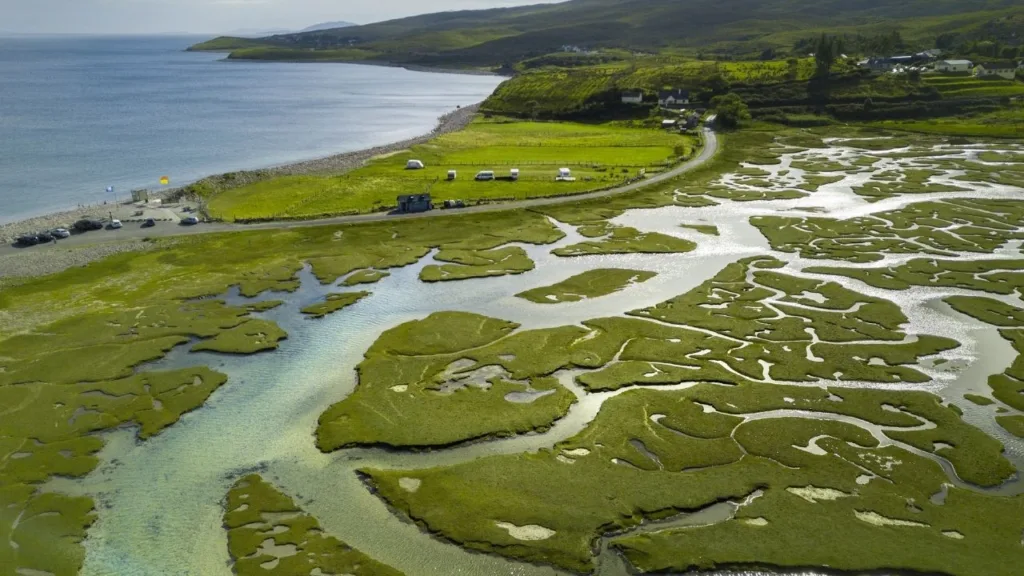FLUVIAL LANDFORMS
Fluvial landforms are the landforms either carved out (due to erosion) or built up (due to deposition) by running water and the running waters that shape them are called fluvial processes which include overland flow and surface flow. The geological works of fluvial processes or rivers are called three-phase work comprising erosion, transportation, and deposition.
The fluvial landforms are divided into two major categories: (1) Erosional landforms and (2) Depositional landforms. The landforms resulting from progressive removal of the bedrock mass are called erosional landforms, e.g. various types of valleys (gorges, canyons, broad and flat, mature and senile valleys, multi-storied valleys, etc.), potholes, rapids and waterfalls structured benches terraces, meanders, etc. The landforms shaped by the deposition of different types of eroded materials become depositional landforms such as alluvial fans and cons, natural levees, flood plains, terraces, deltas, etc.
Fluvial landforms are further divided into EROSIONAL WORK OF RIVER
The erosional work of rivers depends on channel gradient, volume of water, velocity and thus kinetic energy, water discharge, and sediment load. The sediment load of the rivers includes gravel, sand, silt, and clay. Gravels include boulders, cobbles, pebbles, and granules. The quantity, size, and angularity of erosional tools control the nature and magnitude of fluvial erosion.
Types of Fluvial Erosion
The erosional work of the rivers is performed in two ways viz. (i) through chemical erosion and (ii) through mechanical erosion. Chemical erosion involves corrosion or solution and carbonation while Mechanical erosion comprises corrasion or abrasion, hydraulic action, and attrition. Fluvial erosion is also divided into vertical erosion or downcutting and lateral erosion.
- Solution or Corrosion involves the dissolution of soluble materials through the process of disintegration and decomposition of carbonate rocks. The soluble materials are removed from the parent rocks and are mixed with the running water of the streams. Most of the salts are removed from the bedrock through the process of carbonation.
- Abrasion or Corrosion involves the removal of loosened materials from the rocks of valley walls and valley floors with the help of erosional tools (boulders. pebbles, cobbles, etc.).The erosional tools or river loads move down the channel gradient along with water and thus strike against the rocks that come in contact with them. The repetition of this mechanism weakens the rocks which are ultimately loosened and broken down.
- Attrition is the mechanical tear and wear of the erosional tools in themselves. The boulders, cobbles, pebbles, etc., while moving with water collide against each other and thus are fragmented into smaller and finer pieces in transit. Thus, the rock particles are so broken down that ultimately they are communicated into coarse to fine sand particles which are transported down the channel.
- Hydraulic action involves the breakdown of the rocks of valley sides due to the impact of water currents of the channel. Hydraulic action is the mechanical loosening and removal of materials of rocks by water alone.
Erosional Landforms
The valleys carved out by the rivers are significant erosional landforms. The shape and dimension of fluvially-originated valleys change with the advancement of the stages of the fluvial cycle of erosion. The valley formed in the youthful stage of the fluvial cycle of erosion and the initial stage of valley development is V-shaped having a steep valley side slope of the convex element. The valley is very deep and narrow, both the valley sides meet together at the valley floor and thus water always touches the valley sides. Such a type of valley results in accelerated downcutting. V-shaped valleys are further divided into Gorges and Canyons.
Gorges are formed due to active downcutting of the valleys through the process of pothole drilling. This is also formed due to the recession of waterfalls. Most of the Himalayan rivers have carved out deep and narrow gorges. Canyons are an extended form of gorges. Canyons represent very deep, narrow but long valleys. The steepness of the valley sides depends on the nature of the rock.
Waterfall
Waterfalls are caused because of sudden or abrupt breaks in the longitudinal course of rivers due to a host of factors e.g. variation in the relative resistance of rocks, relative difference in topographic reliefs, fall in the sea level and related rejuvenation, earth movements, etc. A waterfall can be defined as a vertical drop of water of enormous volume from a great height in the long profiles of rivers. Waterfalls due to the following reasons:
(a) Waterfalls due to structural and lithological variations
(b) Waterfalls due to faults and fractures
(c) Waterfalls due to upliftment
(d) Waterfalls due to obstruction of rivers
Potholes
The kettle-like depressions in the rocky beds of the river valleys are called potholes which are usually cylindrical. Potholes are generally formed in coarse-grained rocks such as sandstones and granite. Pothole drilling is the mechanism through which grinding tools (fragments of rocks e.g. boulders and angular rock fragments) when caught in water start dancing in a circular manner and grind and drill. Pothole drilling is an effective mechanism of valley deepening.
Structural Benches
The step-like flat surfaces on either side of the present lowest valley floors are called terraces. The benches or terraces formed due to differential erosion of alternate bands of hard and soft rock beds are called structural benches or terraces because of lithological controlling the rate of erosion and consequent development of the benches.
River Terraces
The narrow flat surface on either side of the valley floor is called river terraces which represent the level of former flood plains. Sometimes, the valleys are frequented by several terraces on either side wherein they are arranged in step-like forms. River terraces are generally formed due to the dissection of fluvial sediments of flood plains deposited along a valley floor. River terraces are divided into (I) Paired terraces and (II) Unpaired terraces based on the nature of erosion.
River meanders
River meanders refer to the bends of longitudinal courses of the rivers. The bends of sinuous to severe erosion rivers have been named meanders based on the Meander River of Asia Minor (Turkey) because it flows through numerous bends. Each bend of a meander belt has two types of slope of valley sides.
One side is characterized by a concave slope where the channel strikes the valley sides directly, with the result concave side subjected to severe erosion resulting in the formation of vertical cliffs. This side of the meander cliff is also called as cliff slope side. The other side of the meander belt is characterized by a convex slope which receives deposition mostly sands and gravels but sometimes alluvium is also deposited.
Ox-bow Lakes
The lakes formed due to the impounding of water in the abandoned meander loops are called oxbow or horse-shoe lakes. When the curvature of the meander loops becomes almost circular and the two ends of meander loops come closer, consequently, the streams straighten their courses, and meander loops are abandoned to form oxbow lakes. It may be pointed out that the formation of oxbow lakes owes to erosion and deposition.
Peneplains
Peneplains represent low featureless plains having undulating surfaces and remnants of convex-concave residual hills. These are, in fact, the end products of the normal cycle of erosion. These are frequented with low residual hills known as monadnocks. The end product of a normal cycle of erosion has been named by different geomorphologists e.g. peneplain (W.M. Davis), endrumpf ( W. Penck), peneplain (C.H. Crickmay), peneplain (L.C. King), each plain (Pug and Thomas), pendant (A.C. Lawson), etc.
TRANSPORTATION WORK OF RIVER
Rivers obtain the eroded materials and transport them from one place to another place. Rivers have their limits to transport materials, they cannot transport transport loads if they exceed the transporting power of the streams. River transport their load in different ways e.g. (I) by traction (II) by saltation, (III) by suspension, and (IV) by solution. The traction method consists of gravels, pebbles, cobbles, and boulders. Saltation involves the transportation of rock pieces and boulders by rolling and sliding. The soluble materials are dissolved in water and become invisible. Thus, such materials are transported in solution form and the involved mechanism is known as transportation by solution.
DEPOSITIONAL WORK OF STREAMS
The deposition of load carried by the streams is affected by a variety of factors e.g. (I) decrease in channel gradient,(II) spreading of stream water over a larger area, (III) obstruction in channel flow (IV) decrease in the volume and discharge of water, (V) decrease in the velocity of streams (VI) increase in the load, etc. It may be pointed out that aforesaid factors of river deposition may be grouped into two categories: decrease in river velocity and increase in river load.
Rivers deposit sediments in different parts of their and thus form various types of landforms which are called constructional landforms, such as alluvial fans and alluvial cones, sand banks, natural levees, flood plains, sand bars, and deltas.
Alluvial fans and cons– These are always formed at the base of foothills where there is an abrupt drop in the channel gradient. The transporting capacity of the streams decreases enormously at the foothill zones when they leave the mountains and enter the plains.
Morphology of alluvial fans- The shapes of alluvial fans are usually semi-circular or arcuate, the apex of which is located at the mouth of the narrow opening through which the stream comes out of the hills and enters the surface of low height and gentle slope.
Structure and origin of alluvial fans– Alluvial fans and comes are more or less similar except for a difference in their gradients. Alluvial fans have gentler slopes than the cones. Alluvial cones are formed when the slope of a hill or mountain from through which the stream descends is steep so that debris collects at the foot of the hills.
Natural Levees- The narrow belt of ridges of low height built by the deposition of sediments by the spilled water of the stream in its bank is called a natural levee or natural embankment. Levees are formed due to the deposition of sediments during flood periods when the water overtops the river banks and spreads over adjoining flood plains. The average height of the natural levees is within 10 meters.
The depositional feature of an almost triangular shape at the mouth of a river debouching either in a lake or sea is called a delta. The size of the delta of major and small rivers all over the world varies from a few square kilometers to thousands of square kilometers. The size of the delta depends on the rock characteristics, vegetal cover, rate of erosion, amount of annual rainfall, etc.

Characteristics of Delta
Delta is generally classified based on common characteristics of shape, structure, size, growth, etc. The shape of deltas is determined by the physical conditions such as discharge of water, velocity of stream flow, supply and amount of sediments, rate of subsidence, tidal waves, sea waves, oceanic currents, rate of growth, etc. Generally, deltas are divided on the following two bases-
(1) based on shape
- arcuate delta
- bird-foot delta
- estuarine delta
- truncated delta
(2) based on growth
- growing delta
- blocked delta
Major Deltas of Indian Rivers
Major deltas of Indian rivers include the Ganga Delta, Mahanadi Delta, Godavari Delta, Krishna Delta, and Cauvery Delta. The Ganga delta is the most extensive delta of the world of the world, the arc of which extends for 400 km from Hoogli to Meghna rivers. The Mahanadi delta is a triple delta where deltaic sediments of the Mahanadi, the Brahmani, and the Baitarni are dropped. The Godavari delta extends up to 35 km in the Bay of Bengal off the coast of Andhra Pradesh but the maximum length of the longer side through the middle portion of the delta is 90 km while the other two sides are 150 km. This is also an example of an arcuate-shaped delta.
